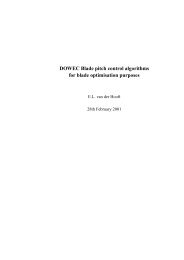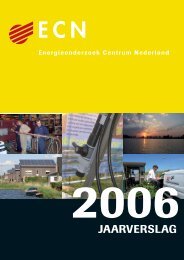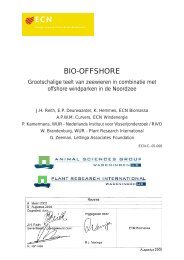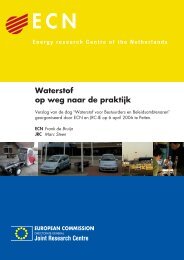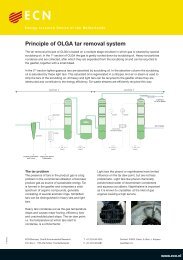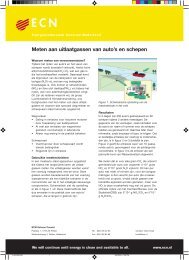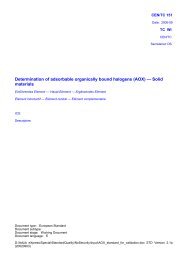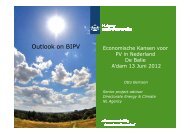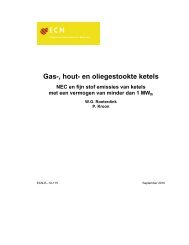PDF format (503 kB) - ECN
PDF format (503 kB) - ECN
PDF format (503 kB) - ECN
Create successful ePaper yourself
Turn your PDF publications into a flip-book with our unique Google optimized e-Paper software.
Energy use reduction potential of passenger transport in Europe and consequences for<br />
CO2 emission<br />
M.E. Bouwman and H.C. Moll<br />
Center for Energy and Environmental Studies IVEM, Groningen University,<br />
Nijenborgh 4, 9747 AG Groningen, The Netherlands<br />
tel. +31 50 3634609; e-mail M.Bouwman@fwn.rug.nl<br />
Abstract<br />
In order to contribute to a sustainable society, considerable reduction in the energy use and CO2 emission<br />
should be achieved. This paper presents a methodology to explore the energy use reduction potential of the<br />
transportation sector. Three types of options are defined emphasising on technological, infrastructural and<br />
behavioural change. With technological and infrastructural options, an energy reduction of over 50% by 2050<br />
can be realised. In order to achieve further energy reductions, also options with large behavioural impact should<br />
be implemented. This results in an 80% energy reduction potential in the transportation sector by the year<br />
2050. The reduction potential for CO2 emission can be increased compared to the energy use reduction<br />
potential by introducing a fuel mix with a low carbon content. If a growing mobility demand is incorporated in<br />
the analyses, the total savings are smaller.<br />
Introduction<br />
The present use of energy and materials and the emission of greenhouse gases of Western Europe contribute<br />
substantially to global resource depletion and global climate change. To contribute to global sustainability, i.e.<br />
stabilisation at 1990 emission level by the year 2050 (Houghton et al., 1995) and leaving room for development<br />
outside the Western world, considerable reductions of the use of energy and materials are required, resulting in<br />
the required reduction of greenhouse gases (mainly CO2).<br />
There is a variety of reduction options such as technological improvements, infrastructure modifications and<br />
behavioural change. Technological improvements aim at increasing the energy and material efficiency and at<br />
substitutions, resulting in a lower overall energy and material consumption. Some technological options<br />
demand large behavioural adaptations e.g. shifting from private to public transportation. Some consequential<br />
substitutions require also a new or a heavily modified infrastructure e.g. to sell a new energy carrier, or to<br />
provide the infrastructure for increased use of public transportation. All such options can be evaluated<br />
individually on their potential to reduce CO2 emissions.<br />
Transport i.e. passenger and freight transport by road and railways contributes for about a quarter (OECD/IEA,<br />
1997) [14 EJ/a] to the total energy consumption and CO2 emissions in OECD Europe. This share justifies a<br />
specific assessment of reduction options in the transportation sector. Moreover, a substantial growth (RIVM,<br />
1992) is foreseen for the performance - expressed in passenger kilometres and ton kilometres - with possibly a<br />
related growth in energy requirements and CO2 emissions.<br />
To stabilise the energy requirement and emissions by transport, at least the impact per unit of performance has<br />
to be halved in he period 2000 - 2050. An equitable distribution of CO2 emissions on a global level in 2050<br />
requires an absolute reduction to one fifth of the current energy consumption and emission levels for OECD<br />
Europe (cf. Mulder and Biesiot, 1998). Combined with the expected growth of transport this long term<br />
reduction objective implies a reduction of the impact per unit of performance to 10% of the present one.<br />
This paper calculates the reduction potential of total energy use of and emissions from passenger transport in<br />
OECD Europe. The general aim is to achieve a 50% reduction by 2020, and a 90% reduction in 2050.<br />
Technological improvements, infrastructure modifications and behavioural change are all considered,<br />
regardless of their implementation problems. This approach yields an indication of the reduction potential. The<br />
reduction potential is calculated for both the individual category of options, and the combined total.



